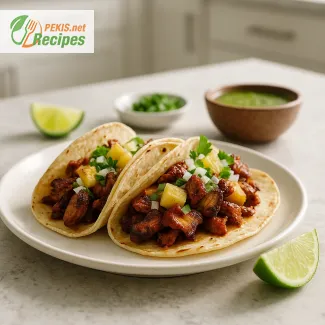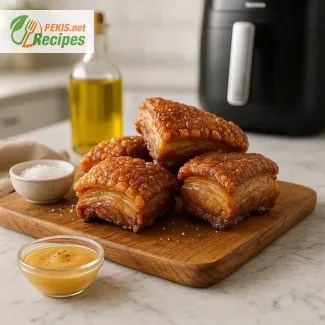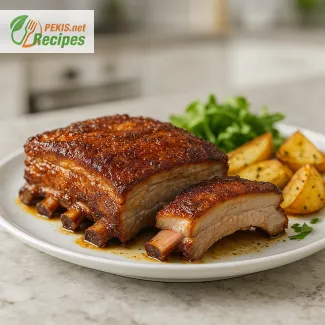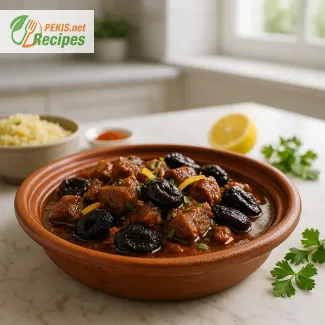Karelian Hot Pot (Karjalanpaisti) serves 4 portions, with a 20-minute preparation, 150-minute cook time, and a 170-minute total. Combining beef, pork, onions, carrots, garlic, and bay leaves, it transforms into a deeply flavorful stew through slow cooking. The result is tender meat in a rich, aromatic broth that highlights simplicity and Nordic tradition. It keeps well for 2 days at room temperature or up to 2 months frozen, making it ideal for advance preparation. Served with boiled potatoes, rye bread, or pickled cucumbers, this dish captures the comforting essence of Finnish home cooking.
PEKIS – professional chef and recipe developer with over 25 years of experience, specialized in European and international cuisine. With a deep appreciation for Nordic traditions, I have prepared countless versions of Karelian Hot Pot, bringing out the authentic flavors while adapting it to modern home kitchens.
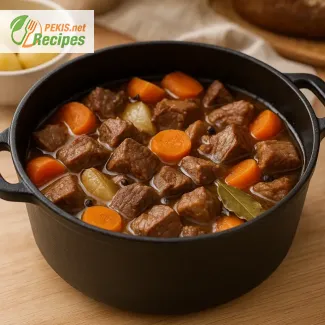
Traditional Karelian Hot Pot from Finland
A slow-cooked stew with rich flavors and cultural heritage
Karelian Hot Pot (Karjalanpaisti) stands as one of the most iconic dishes of Finland, often celebrated as the country’s national stew. With its roots in the eastern region of Karelia, this hearty preparation captures the essence of Finnish home cooking – simple, honest, and deeply satisfying. At its core, it combines different cuts of meat, typically pork and beef, gently simmered with root vegetables and aromatic spices until the flavors merge into a warming, rustic stew. The slow cooking process makes the meat exceptionally tender, while the broth develops a silky depth that brings comfort during long, cold winters.
Unlike many complex European stews that rely on heavy sauces, this dish is defined by its purity of flavors. Each ingredient contributes naturally – the sweetness of carrots, the earthiness of onions, and the subtle balance of peppercorns and bay leaves. Nothing is masked; instead, every element has a purpose, creating a dish that is nourishing yet never overwhelming.
Origins and cultural significance of Karjalanpaisti
The history of this stew reaches back centuries, with origins in Karelia, a region once divided between Finland and Russia. Traditionally prepared during holidays and family gatherings, Karjalanpaisti symbolized abundance and warmth. Families would use whatever meats were available, often layering them in a clay pot and leaving it to cook slowly in a wood-fired oven. The recipe’s endurance across generations speaks to its role not just as food but as a cultural connector, preserving a piece of Finnish identity through flavor and tradition. Today, it remains a dish served on festive occasions, from Christmas to weddings, while also appearing as a comforting weekend meal in Finnish households.
Why you will love this dish
- Authentic Nordic tradition in every bite.
- Simple ingredients that transform into a rich, layered stew.
- Perfect for gatherings, feeding many with minimal effort.
- Versatile preparation, adapting easily to different cuts of meat.
- Naturally warming, ideal for colder seasons or cozy evenings.
Key characteristics of Karelian Hot Pot
- Cooking method: Slow baking or simmering ensures the meats release juices that blend with vegetables into a hearty broth.
- Texture: Meat becomes fork-tender, while the vegetables soften without losing their integrity.
- Flavor profile: Balanced, mild, and aromatic rather than spicy, highlighting the quality of the raw ingredients.
- Serving style: Traditionally presented with boiled potatoes, rye bread, or pickled cucumbers, making it a full and satisfying meal.
Creative variations and serving ideas
Although the traditional version focuses on beef and pork, modern cooks enjoy experimenting:
- Game meats such as venison or elk add a wilder, richer note.
- Lamb offers a slightly sweeter, softer texture.
- Root vegetable focus, increasing parsnips, turnips, or rutabaga for a lighter but still hearty option.
- Herbal infusions, like thyme or rosemary, can enhance depth while maintaining authenticity.
- Wine-based variation, replacing part of the water with red wine, creates a more robust European-style stew.
These adaptations keep the essence of the dish intact while allowing creativity for different occasions.
Storage and make-ahead preparation
One of the advantages of this dish is its ability to improve over time as flavors deepen.
- Room temperature: Keeps safely for up to 2 days when covered.
- Refrigeration: Ideal for up to 4 days in a sealed container.
- Freezing: Stores well for up to 2 months without loss of flavor or texture.
- Reheating: Best warmed slowly in the oven at 150 °C (300 °F) for 8–10 minutes, or gently on the stove to preserve tenderness.
Traditional companions and modern pairings
- Classic Finnish sides: Steamed or boiled potatoes, buttered rye bread, and lingonberry preserves.
- Refreshing balance: Pickled vegetables or cucumbers cut through the richness.
- Modern touches: Pairing with mashed root vegetables, sourdough bread, or a glass of dry red wine.
By combining deep cultural roots with a flavor profile that appeals universally, Karelian Hot Pot continues to hold a cherished place both in Finnish homes and in the wider world of comfort food.
- Preheat the oven to 160 °C (320 °F).
- Cut the beef and pork into equal bite-sized cubes.
- Peel and slice the onions into wedges, carrots into thick rounds, and mince the garlic.
- In a large ovenproof casserole dish or Dutch oven, layer the meat pieces alternately with vegetables.
- Add bay leaves, peppercorns, and salt evenly between the layers.
- Pour in water until it just covers the meat and vegetables.
- Cover the dish with a lid and place it in the oven.
- Cook slowly for about 2.5 hours until the meat is tender and the flavors have fully blended.
- Remove the bay leaves before serving.
- Serve hot with boiled potatoes, rye bread, or pickled cucumbers.
FAQ questionWhat cuts of meat work best?
Use a mix of beef chuck (or stewing beef) and pork shoulder/neck cut into equal cubes. This combination gives the classic balance of tender texture and rich flavor after long, gentle cooking.
FAQ questionDo I need to brown the meat first?
Traditional versions often do not sear; the layered, slow-baked method yields a clear, aromatic broth. If you prefer deeper flavor, lightly brown half the meat in batches and keep the rest raw to preserve the stew’s signature clarity.
FAQ questionHow much liquid should I add?
Add just enough water to barely cover the layered meat and vegetables—typically about 1 L per 1–1.2 kg total meat. Too much liquid dilutes flavor; the best result is a concentrated, savory broth.
FAQ questionWhich vegetables are traditional, and what can I swap?
Core vegetables are onions and carrots. Optional additions include parsnip, rutabaga, or celeriac cut in large chunks. Avoid starchy thickeners; the stew should stay brothy, not gravy-thick.
FAQ questionWhat spices are authentic?
Keep it minimal: bay leaves, whole black peppercorns, and salt. The dish relies on the purity of ingredients, not complex spice blends.
FAQ questionCan I cook it without an oven?
Yes. On the stovetop, keep at a gentle simmer (not a rolling boil) for 2–3 hours with the lid on. In a slow cooker, cook 6–8 hours on low or 4–5 hours on high, ensuring the stew remains barely bubbling.
FAQ questionHow do I keep the meat tender?
Cut uniform cubes, avoid vigorous boiling, and cook low and slow with the lid on. Salt lightly at the start, then adjust salt towards the end to prevent tightening the protein early on.
FAQ questionWhat should I serve with it?
Classic sides are boiled potatoes, rye bread, and pickled cucumbers. A small spoon of lingonberry jam adds bright acidity that balances the rich, meaty broth.
FAQ questionIs it gluten-free and dairy-free?
The stew itself is naturally gluten-free and dairy-free. Gluten enters only through sides like rye bread—choose gluten-free bread or stick to potatoes to keep the meal fully gluten-free.
FAQ questionHow should I store leftovers safely?
Cool within 2 hours, then refrigerate in a shallow container for up to 4 days. For longer storage, freeze up to 2 months. Reheat gently to an internal temperature of 74 °C; in the oven, 150 °C for 8–10 minutes per portion (or longer for a full casserole), or simmer on the stovetop until hot.
FAQ questionCan I add wine or other flavor boosters?
Not traditional, but you can replace 200–250 ml of the water with dry red wine for a rounder profile. Fresh thyme or a small piece of rosemary complements the meat while keeping the flavor clean and Nordic.
FAQ questionHow can I reduce greasiness?
Trim visible fat before cooking. After chilling, lift the solidified fat from the surface. This preserves the meaty depth while giving a cleaner mouthfeel.
The depth of Karelian Hot Pot lies in its ability to transform a handful of humble ingredients into a dish full of comfort and tradition. With beef, pork, onions, carrots, garlic, and bay leaves, every element contributes naturally, creating a stew that feels both rustic and timeless. Its slow cooking method ensures flavors meld together into something far greater than the sum of its parts.
What makes this Finnish stew truly special is its connection to heritage. Generations have passed down the method of layering meat and vegetables in a heavy pot, letting time and gentle heat bring out their best qualities. This simple ritual carries with it the warmth of family gatherings, seasonal celebrations, and the essence of Finnish hospitality.
Versatility is another reason why Karjalanpaisti endures. While the traditional recipe remains a favorite, creative adaptations with game meats, root vegetables, or a splash of wine keep it alive in modern kitchens. Its structure welcomes personal touches without losing the authentic spirit that defines it.
Equally important is its practicality. The stew stores well, tastes even better the next day, and can be frozen for weeks, making it a reliable choice for advance planning. Reheated gently, it preserves its tenderness and depth, turning any meal into an effortless yet impressive experience.
When served with boiled potatoes, rye bread, or pickled cucumbers, Karelian Hot Pot embodies the essence of Nordic comfort food. It offers nourishment not only for the body but also for the soul, carrying with it a story of endurance, community, and timeless flavor.
Allergens present in the recipe:
- None in the stew itself. Gluten may be present if served with rye bread.
Suggestions for substitutions:
- To make the dish gluten-free, serve with gluten-free bread or boiled potatoes only.
- For those avoiding garlic, simply omit it without losing authenticity.
- Replace pork with lamb or chicken for dietary preferences.
- Vitamin A: 5100 IU – supports eye health and immunity.
- Vitamin B12: 3.6 µg – essential for red blood cell production and nerve health.
- Vitamin C: 12 mg – contributes to collagen formation and immune defense.
- Iron: 4.2 mg – crucial for oxygen transport in the blood.
- Zinc: 6.5 mg – important for metabolism and immune support.
- Potassium: 920 mg – helps regulate blood pressure and fluid balance.
- Magnesium: 55 mg – supports muscle and nerve function.
- Beta-carotene: 4.8 mg – converted into vitamin A, promotes healthy skin and vision.
- Selenium: 22 µg – protects cells from oxidative stress.
- Polyphenols (from onions and carrots): 180 mg – contribute to anti-inflammatory effects and improved heart health.

